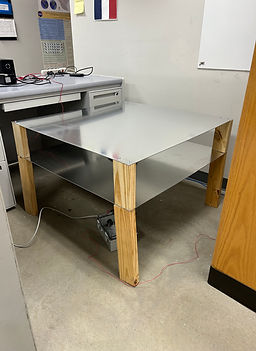
Texas A&M University - Corpus Christi Balloon Launching Group recovering a sonde during the October 2023 annular eclipse.

Photo of the October 2023 annular eclipse taken near George West, TX. Photo taken by Raven Vasquez.
NSF Balloon and Electric Field Mill Deployments in coordination with the October 2023 and April 2024 Solar Eclipses over Texas:
I am currently a supervisor for a recently funded NSF student engagement project to launch weather balloons during the two eclipses that will traverse Texas in 2023 and 2024. I will be in charge of leading a workshop to teach undergraduate students how to solder, CAD techniques, how to construct an instrument box, how to wire sensors to a raspberry pi, weather balloon launching techniques, amongst other topics.
Corpus Christi, TX sits in the unique location to have observed the complete annular eclipse recently in October 2023, and lies within a three-hour drive of the total solar eclipse which will occur in April 2024.
This funded project intends to engage the students in multiple areas of STEM. The balloon package will be completely developed, constructed, wired, and coded from scratch by undergraduate students. In addition to a traditional radiosonde, this package includes relatively inexpensive microsensors measuring atmospheric parameters including temperature, pressure, relative humidity, UV, light, 9 axis Magnetic field, PM2.5, PM10, ozone (O3), Carbon Monoxide (CO), among several others.
We plan to launch several of the student constructed sondes alongside a well calibrated ozonesonde provided by Saint Edwards University in Austin, TX. This would provide the opportunity for undergraduate students to calibrate the inexpensive and potentially underutilized microsensors. Additionally, the students will collect, analyze, and calibrate the data during the time of the total eclipse. The launch will be coordinated to release the balloon so that the package reaches the Upper Troposphere Lower Stratosphere (UTLS) during the peak of the eclipse. This hands-on data analysis would further enhance the student’s experience, and results would be presented at a conference later in the year.
In coordination with the weather balloon release, this project also plans to deploy a network of 4-5 Campbell Scientific (CS110) electric field mills strategically spaced-out around the balloon release point, and predicted balloon track. This will provide additional hands-on instrumentation experience for the students, as well as build communication and coordination skills in the field. Utilizing this small network of CS110’s, the students will try to discern any influence on the sudden loss of sunlight on the vertical electric field of the atmosphere.

NASA Dynamics and Chemistry of the Summer Stratosphere (DCOTSS) stratospheric balloon launches:
During the spring and summer of 2021 and 2022, I supervised stratospheric ozonesondes in coordination with the NASA DCOTSS field campaign. We measured the ozone mixing ratio, and partial pressure, along with the typical radiosonde measurements.
This data will hopefully help to understand the roll of overshooting storms on ozone concentrations in the United States. Ozone acts as an invisible shield and protects us from harmful ultraviolet (UV) radiation from the sun. In particular, the ozone layer protects us from the UV radiation, known as UV-B, which causes sunburn. This field study aims to understand how water vapor and other chemicals which are injected from deep convection influence the ozone layer above the US.


Calibration, Testing and Future Ideas for 6 Aircraft Electric Field Mills on Loan from the NCAR RAF Facility:
From January 2024-December 2024, I have been loaned 6 aircraft electric field mills (E100s) developed by New Mexico Tech in 1986. The E100s have been previously deployed on numerous aircraft and ground based field campaigns.
The E100s are designed to be sensitive to very high magnitude electric fields. We are currently testing to see how sensitive they are to smaller magnitude electric fields, such as fair-weather and warm rain events.
We are currently calibrating the E100 against a highly calibrated CS110 electrif field mill both in a calibration chamber and outside during precipitation events.
Once the calibration is complete, the next step is to propose to deploy these instruments on an NSF aircraft campaign if possible.


CS110 Electric Field Meter and Texas A&M University-Corpus Christi Campus Weather Tower.
Other Instrumentation:
Here are some pictures of instrumentation that I have helped to set up and maintain:


Texas A&M University - Corpus Christi Mobile Weather Station
CS110 Electric Field Meter installed in Barrow, AK

CS110 Electric Field Meter installed in Wallops Island, VA

Rain bucket and laser disdrometer obtained as a part of the NASA MSI Pro